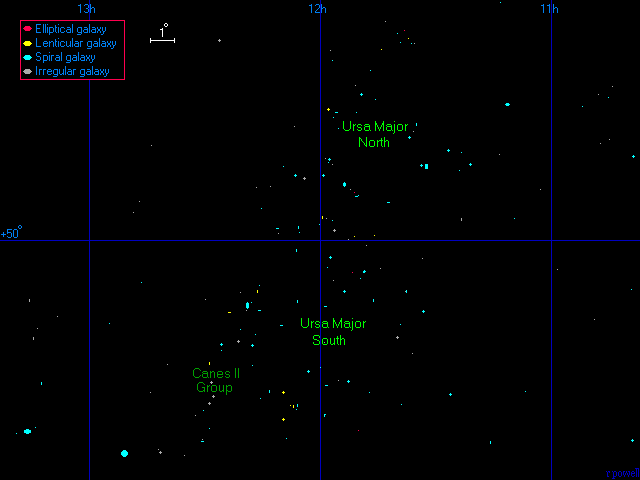
The Ursa Major Groups are a very distinctive band of galaxies in the northern hemisphere. Unlike the dense enviroment of the Virgo cluster, most of the major galaxies here are spiral galaxies. This band of galaxies is usually split into two distinct groups - Ursa Major North and Ursa Major South, but there is no real boundary between the two groups and the galaxies in both groups lie at approximately the same distance from us. The nearer Canes II Group is also in this part of the sky next to the Ursa Major South group.

This is a map of the Ursa Major North Group. This is most of the major galaxies in this group which lie north of 50 degrees which is a fairly arbitary boundary. There are no major elliptical galaxies here - most of the largest galaxies are spirals.

Below - three of the galaxies in the Ursa Major North group. NGC 3631 (left), NGC 3953 (centre) and NGC 4088 (right) are three of the brightest spiral galaxies in this group.
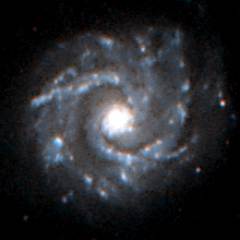 |
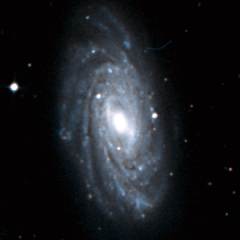 |
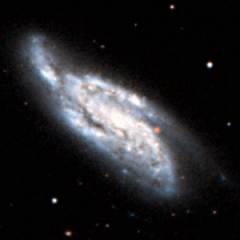 |
| NGC 3631 | NGC 3953 | NGC 4088 |
This is a list of the largest galaxies in the Ursa Major North Group. There are 32 galaxies in this group with a diameter above thirty thousand light years.
1 2 3 4 5 6 7 8
Name Equatorial Blue Type Size Size RV
Coordinates Mag (') kly km/s
RA Dec
NGC 3556 11 11.5 +55 40 10.9 SBc 8.1 130 865
NGC 3631 11 21.0 +53 10 11.1 Sc 4.9 80 1344
UGC 6399 11 23.4 +50 54 14.3 Sm 2.6 40 996
UGC 6446 11 26.7 +53 45 13.8 Scd 2.8 45 826
NGC 3718 11 32.6 +53 04 11.6 SBa 7.6 120 1177
NGC 3729 11 33.8 +53 07 12.1 SBa 2.9 45 1214
NGC 3733 11 35.0 +54 51 13.0 SBc 4.5 70 1360
UGC 6575 11 36.4 +58 12 14.6 Sc 1.9 30 1372
NGC 3756 11 36.8 +54 18 12.3 SBbc 3.8 60 1467
UGC 6616 11 39.3 +58 16 14.3 Sc 2.3 35 1306
NGC 3795 11 40.1 +58 37 14.2 Sbc 2.1 35 1364
UGC 6667 11 42.5 +51 36 14.3 Sc 2.6 40 1169
NGC 3850 11 45.6 +55 53 14.4 SBc 1.9 30 1324
NGC 3898 11 49.3 +56 05 11.6 Sab 3.7 60 1343
NGC 3913 11 50.6 +55 21 13.4 Scd 2.4 40 1125
NGC 3917 11 50.8 +51 49 12.5 Sc 5.0 80 1159
NGC 3922 11 51.2 +50 09 13.9 S0 1.9 30 1199
UGC 6840 11 52.1 +52 06 14.6 SBm 2.0 35 1234
UGC 6849 11 52.7 +50 02 14.9 Sm 1.7 30 1194
NGC 3953 11 53.8 +52 20 10.9 SBbc 7.6 120 1240
NGC 3972 11 55.8 +55 19 13.0 SBbc 3.7 60 1016
UGC 6917 11 56.5 +50 26 13.3 SBm 3.5 55 1108
NGC 3982 11 56.5 +55 07 12.1 SBb 2.3 40 1280
M109,NGC 3992 11 57.6 +53 23 10.8 SBbc 6.9 110 1229
NGC 3998 11 57.9 +55 27 11.6 S0 2.9 45 1211
UGC 6983 11 59.2 +52 42 13.4 SBc 3.1 50 1262
NGC 4026 11 59.4 +50 58 11.7 S0 4.8 75 1129
NGC 4085 12 05.4 +50 21 13.2 SBc 2.5 40 943
NGC 4088 12 05.6 +50 32 11.2 SBc 6.0 95 951
NGC 4102 12 06.4 +52 43 12.0 SBb 3.1 50 1026
NGC 4142 12 09.5 +53 06 13.9 SBcd 2.1 35 1337
NGC 4157 12 11.1 +50 29 12.1 SBb 6.6 105 967
|
Column 1: The usual name of the galaxy.
Column 2: The Right Ascension for epoch 2000.
Column 3: The Declination for epoch 2000.
Column 4: The blue apparent magnitude of the galaxy.
Column 5: The galaxy type: E=Elliptical, S0=Lenticular, Sa,Sb,Sc,Sd=Spiral,
SBa,SBb,SBc,SBd=Barred Spiral, Sm,SBm,Irr=Irregular.
Column 6: The angular diameter of the galaxy (arcminutes).
Column 7: The diameter of the galaxy (thousands of light years).
Column 8: The recessional velocity (km/s) of the galaxy relative to
the cosmic microwave background.
References:
The HyperLeda Database, (2003).
Shown below is the spiral galaxy M109. This is one of the brightest galaxies in the group. The Messier Catalogue contains 39 galaxies, and this is probably the galaxy in the catalogue which looks most like the Milky Way.
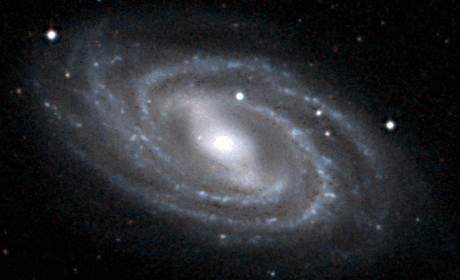
| Properties of the Ursa Major North Group | |
|---|---|
| Equatorial Coordinates | RA=11h40m Dec=+4° |
| Galactic Coordinates | l=114° b=+60° |
| Supergalactic Coordinates | L=60° B=+2° |
| Distance to the centre of the group | 55 million light years |
| Number of large galaxies in the group | 32 |
This is a map of the Ursa Major South Group. These are most of the major galaxies in this group which lie south of 50 degrees. Like the Ursa Major North Group most of the major galaxies in this group are spiral galaxies.
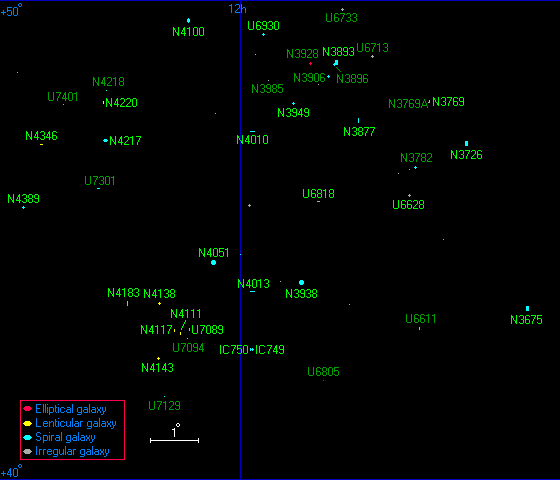
Below - three of the galaxies in the Ursa Major South group. NGC 3675 (left), NGC 3726 (centre) and NGC 3938 (right) are three of the brightest spiral galaxies in this group.
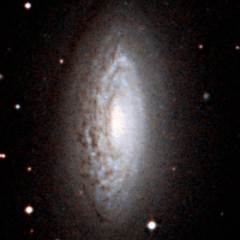 |
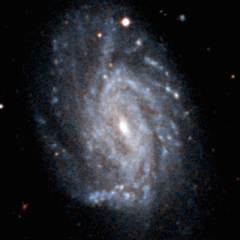 |
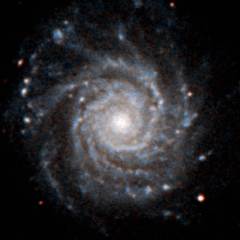 |
| NGC 3675 | NGC 3726 | NGC 3938 |
This is a list of the largest galaxies in the Ursa Major South Group. There are 28 galaxies in this group with a diameter above thirty thousand light years.
1 2 3 4 5 6 7 8
Name Equatorial Blue Type Size Size RV
Coordinates Mag (') kly km/s
RA Dec
UGC 6161 11 06.8 +43 43 16.0 SBd 1.8 30 991
NGC 3600 11 15.9 +41 35 14.0 Sa 3.6 60 962
NGC 3675 11 26.1 +43 35 11.0 Sb 6.2 100 1001
NGC 3726 11 33.4 +47 02 10.9 SBc 6.0 95 1073
NGC 3769 11 37.7 +47 54 12.6 SBb 2.8 45 942
UGC 6628 11 40.1 +45 57 13.4 SBm 2.7 45 1071
NGC 3877 11 46.1 +47 30 11.8 Sc 5.2 85 1113
NGC 3893 11 48.6 +48 43 11.4 SBc 4.1 65 1177
UGC 6818 11 50.8 +45 48 14.7 Irr 1.9 30 1036
NGC 3938 11 52.8 +44 07 11.1 Sc 5.0 80 1037
NGC 3949 11 53.7 +47 51 11.7 Sbc 2.7 45 1010
UGC 6930 11 57.3 +49 17 12.9 SBcd 3.3 55 980
NGC 4013 11 58.5 +43 57 12.3 Sb 4.8 75 1064
IC 749 11 58.6 +42 44 13.0 SBc 2.2 35 1001
NGC 4010 11 58.6 +47 16 13.3 SBcd 3.9 60 1117
IC 750 11 58.9 +42 43 13.0 Sab 2.6 40 932
NGC 4051 12 03.2 +44 32 10.9 SBbc 5.1 80 934
UGC 7089 12 06.0 +43 09 14.0 Sd 3.2 50 1004
NGC 4100 12 06.1 +49 35 11.9 Sbc 5.2 85 1273
NGC 4111 12 07.1 +43 04 11.5 S0 3.3 55 1027
NGC 4117 12 07.8 +43 08 14.2 S0 1.9 30 1163
NGC 4138 12 09.5 +43 41 12.2 S0 3.0 45 1131
NGC 4143 12 09.6 +42 32 11.8 S0 2.9 45 1152
NGC 4183 12 13.3 +43 42 12.9 Sc 5.1 80 1157
NGC 4217 12 15.8 +47 06 12.1 Sb 4.9 80 1232
NGC 4220 12 16.2 +47 53 12.3 S0 3.6 60 1130
NGC 4346 12 23.5 +47 00 12.1 S0 3.2 50 980
NGC 4389 12 25.6 +45 41 12.6 SBbc 2.5 40 931
|
Column 1: The usual name of the galaxy.
Column 2: The Right Ascension for epoch 2000.
Column 3: The Declination for epoch 2000.
Column 4: The blue apparent magnitude of the galaxy.
Column 5: The galaxy type: E=Elliptical, S0=Lenticular, Sa,Sb,Sc,Sd=Spiral,
SBa,SBb,SBc,SBd=Barred Spiral, Sm,SBm,Irr=Irregular.
Column 6: The angular diameter of the galaxy (arcminutes).
Column 7: The diameter of the galaxy (thousands of light years).
Column 8: The recessional velocity (km/s) of the galaxy relative to
the cosmic microwave background.
References:
The HyperLeda Database, (2003).
Shown below is a picture of NGC 4051, another of the spiral galaxies in this group. NGC 4051 is known to be a Seyfert galaxy which means that it has a bright point-like nucleus probably powered by matter falling into a supermassive blackhole.
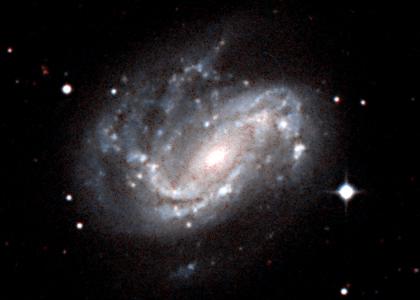
| Properties of the Ursa Major South Group | |
|---|---|
| Equatorial Coordinates | RA=11h55m Dec=+46° |
| Galactic Coordinates | l=150° b=+68° |
| Supergalactic Coordinates | L=69° B=+1° |
| Distance to the centre of the group | 55 million light years |
| Number of large galaxies in the group | 28 |